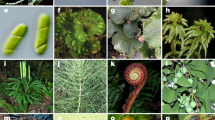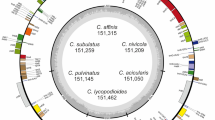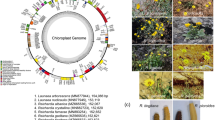Abstract
Photosynthetic eukaryotes, particularly unicellular forms, possess a fossil record that is either wrought with gaps or difficult to interpret, or both. Attempts to reconstruct their evolution have focused on plastid phylogeny, but were limited by the amount and type of phylogenetic information contained within single genes1,2,3,4,5. Among the 210 different protein-coding genes contained in the completely sequenced chloroplast genomes from a glaucocystophyte, a rhodophyte, a diatom, a euglenophyte and five land plants, we have now identified the set of 45 common to each and to a cyanobacterial outgroup genome. Phylogenetic inference with an alignment of 11,039 amino-acid positions per genome indicates that this information is sufficient — but just barely so — to identify the rooted nine-taxon topology. We mapped the process of gene loss from chloroplast genomes across the inferred tree and found that, surprisingly, independent parallel gene losses in multiple lineages outnumber phylogenetically unique losses by more than 4:1. We identified homologues of 44 different plastid-encoded proteins as functional nuclear genes of chloroplast origin, providing evidence for endosymbiotic gene transfer to the nucleus in plants.
This is a preview of subscription content, access via your institution
Access options
Subscribe to this journal
Receive 51 print issues and online access
$199.00 per year
only $3.90 per issue
Buy this article
- Purchase on Springer Link
- Instant access to full article PDF
Prices may be subject to local taxes which are calculated during checkout


Similar content being viewed by others
References
Palenik, B. & Haselkorn, R. Multiple evolutionary origins of prochlorophytes, the chlorophyll b-containing prokaryotes. Nature 355, 265–267 (1992).
Urbach, E., Robertson, D. L. & Chisolm, S. W. Multiple evolutionary origins of prochlorophytes within the cyanobacterial radiation. Nature 355, 267–270 (1992).
Helmchen, T. A., Bhattacharya, D. & Melkonian, M. Analyses of ribosomal RNA sequences from glaucocystophyte cyanelles provide new insights into the evolutionary relationships of plastids. J. Mol. Evol. 41, 203–210 (1995).
Van de Peer, Y., Rensing, S., Maier, U.- & De Wachter, R. Substitution rate calibraiton of small subunit RNA identifies chlorarachniophyte endosymbionts as remnants of green algae. Proc. Natl Acad. Sci. USA 93, 7744–7748 (1996).
Melkonian, M. Systematics and evolution of the algae: Endocytobiosis and the evolution of the major algal lineages. Progr. Bot. 57, 281–311 (1996).
Hallick, R. B.et al. Complete sequence of Euglena gracilis chloroplast DNA. Nucleic Acids Res. 21, 3537–3544 (1993).
Kaneko, T.et al. Sequence analysis of the gneome of the unicellular cyanobacterium Synechocystis sp. strain PCC6803. II. Sequence determination of the entire genome and assigment of potential protein-coding regions. DNA Res. 3, 109–136 (1996).
Martin, W. & Schnarrenberger, C. The evolution of the Calvin cycle from prokaryotic to eukaryotic chromosomes: a case study of functional redundancy in ancient pathways through endosymbiosis. Curr. Genet. 32, 1–18 (1997).
Saitou, N. & Nei, M. The neighbor-joining method: A new method for reconstructing phylogenetic trees. Mol. Biol. Evol. 4, 406–425 (1987).
Adachi, J. & Hasegawa, M. Computer Science Monographs, No. 28. MOLPHY Version 2.3: Programs for Molecular Phylogenetics Based on Maximum Likelihood.(Institute of Statistical Mathematics, Tokyo, 1996).
Akaike, H. Anew look at the statistical model identification. IEEE Trans. Autom. Contr. CA19, 716–723 (1974).
Hedtke, B., Börner, T. & Weihe, A. Mitochondrial and chloroplast phage-like RNA polymerases in Arabidopsis. Science 277, 809–811 (1997).
Naylor, G. J. P. & Brown, W. M. Structural biology and phylogenetic estimation. Nature 388, 527–528 (1997).
Adachi, J. & Hasegawa, M. Model of amino acid substitution in proteins encoded by mitochondrial DNA. J. Mol. Evol. 42, 459–468 (1996).
Lockhart, P. J., Steel, M. A., Hendy, M. D. & Penny, D. Recovering evolutionary trees under a more realistic model of sequence evolution. Mol. Biol. Evol. 11, 605–612 (1994).
Lockhart, P. J., Larkum, A. W., Steel, M., Waddell, P. J. & Penny, D. Evolution of chlorophyll and bacteriochlorophyll: the problem of invariant sites in sequence analysis. Proc. Natl Acad. Sci. USA 93, 1930–1934 (1996).
Gibbs, S. P. The chloroplast of Euglena may have evolved from symbiotic green algae. Can. J. Bot. 56, 2883–2889 (1978).
Cavalier-Smith, T. Kingdom Protozoa and its 18 phyla. Microbiol. Rev. 57, 953–994 (1993).
Henze, K.et al. Anuclear gene of eubacterial origin in Euglena reflects cryptic endosymbioses during protist evolution. Proc. Natl Acad. Sci. USA 92, 9122–9126 (1995).
Cavalier-Smith, T.et al. Cryptomonad nuclear and nucleomorph 18S rRNA phylogeny. Eur. J. Phycol. 31, 315–328 (1996).
Kowallik, K. V., Stöbe, B., Schaffran, I., Kroth-Pancic, P. & Freier, U. The chloroplast genome of a chlorophyll a+c containing alga, Odontella sinensis. Plant Mol. Biol. Reptr. 13, 336–342 (1995).
Löffelhardt, W. & Bohnert, H. J. in The Molecular Biology of Cyanobacteria (ed. Bryant, D. A.) 56–89 (Kluwer, Dordrecht, 1994).
Wakasugi, T.et al. Loss of all ndh genes as determined by sequencing the entire chloroplast genome of black pine Pinus thunbergii. Proc. Natl Acad. Sci. USA 91, 9794–9798 (1994).
Herrmann, R. G. in Eukaryotism and Symbiosis (eds Schenk, H. E. A., Herrmann, R. G., Jeon, K. W. & Schwemmler, W.) 73–118 (Springer, Heidelberg, 1997).
Lynch, M. Mutation accumulation in transfer RNAs: Molecular evidence for Muller's ratchet in mitochondrial genomes. Mol. Biol. Evol. 13, 209–220 (1996).
Moran, N. A. Accelerated evolution and Muller's ratchet in endosymbiotic bacteria. Proc. Natl Acad. Sci. USA 93, 2873–2878 (1996).
Martin, W. & Müller, M. The hydrogen hypothesis for the first eukaryote. Nature 392, 37–41 (1998).
Felsenstein, J. PHYLIP (Phylogeny inference package) manual, version 3.5c(Univ. Washington, Seattle, Dept Genetics, 1993).
Thompson, J. D., Higgins, D. G. & Gibson, T. J. CLUSTALW: Improving the sensitivity of progressive multiple sequence alignment through sequence weighting, position-specific gap penalties and weight matrix choice. Nucleic Acids Res. 22, 4673–4680 (1994).
Maier, R. M., Neckermann, K., Igloi, G. L. & Kössel, H. Complete sequence of maize chloroplast genome: Gene content, hotspots of divergence and the tuning of genetic information by transcript editing. J. Mol. Biol. 251, 614–628 (1995).
Acknowledgements
We thank R. G. Herrmann for discussion, H. Phillipe for comments on the manuscript, the Rechenzentrum der Universität Braunschweig for use of computer facilities, and the Deutsche Forschungsgemeinschaft (W.M. and K.V.K.) and the Ministry of Education, Science, Sports and Culture of Japan (M.H.) for financial support. B.S. is the recipient of a psotdoctoral stipend from the DFG; V.G. is the recipient of a Ph.D. stipend from DAAD.
Author information
Authors and Affiliations
Corresponding author
Rights and permissions
About this article
Cite this article
Martin, W., Stoebe, B., Goremykin, V. et al. Gene transfer to the nucleus and the evolution of chloroplasts. Nature 393, 162–165 (1998). https://doi.org/10.1038/30234
Received:
Accepted:
Issue Date:
DOI: https://doi.org/10.1038/30234
This article is cited by
-
Spatial and temporal characterization of the rich fraction of plastid DNA present in the nuclear genome of Moringa oleifera reveals unanticipated complexity in NUPTs´ formation
BMC Genomics (2024)
-
Plastome comparison reveals hotspots of nucleotide diversity and positive selection pressure on accD, matK, psaA and rbcL genes in Smilacaceae
Brazilian Journal of Botany (2024)
-
Chloroplasts evolved an additional layer of translational regulation based on non-AUG start codons for proteins with different turnover rates
Scientific Reports (2023)
-
Comparative plastomes and phylogenetic analysis of seven Korean endemic Saussurea (Asteraceae)
BMC Plant Biology (2022)
-
Assembly and comparative analysis of the first complete mitochondrial genome of Acer truncatum Bunge: a woody oil-tree species producing nervonic acid
BMC Plant Biology (2022)
Comments
By submitting a comment you agree to abide by our Terms and Community Guidelines. If you find something abusive or that does not comply with our terms or guidelines please flag it as inappropriate.



